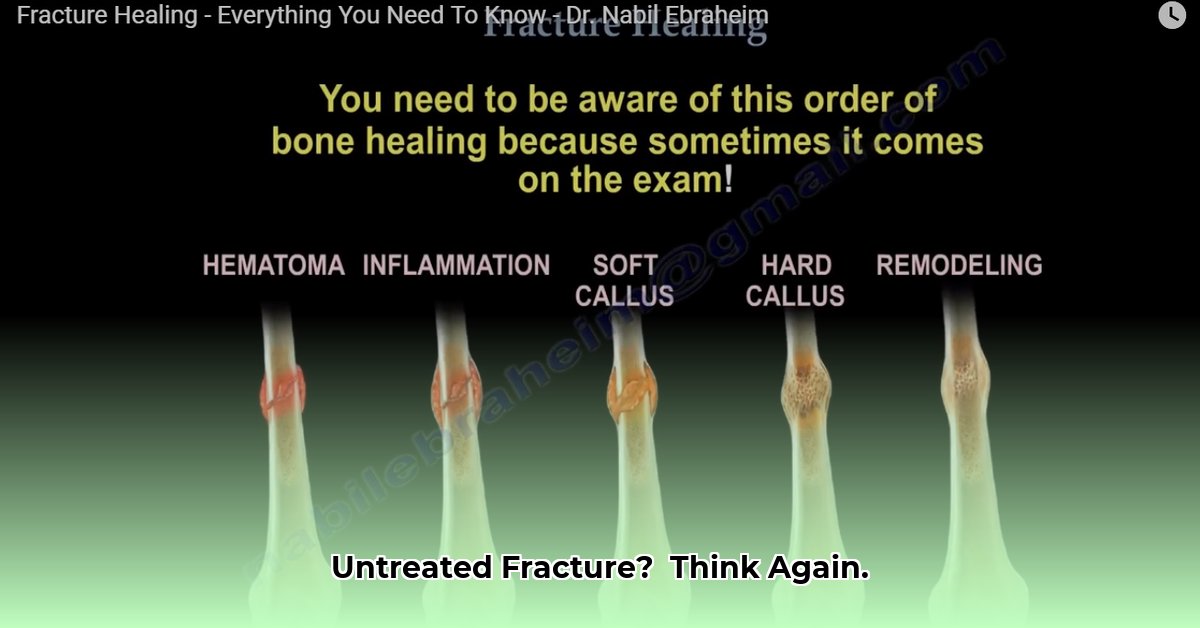Suspect you’ve fractured a bone? While the body has an amazing ability to heal, ignoring a fracture can have serious consequences. This guide provides crucial information on what to do if you suspect a fracture, why medical care is vital, and what to expect during the healing process.
What to Do if You Suspect a Fracture: Immediate Steps
If you think you might have a fracture, taking the right steps immediately can make a significant difference in your recovery. Follow the RICE protocol:
-
Rest (Immobilize): Keep the injured area as still as possible. A makeshift splint using a rolled-up magazine or sturdy cardboard can help stabilize the area. A sling can support an arm injury. Be careful not to restrict blood flow.
-
Ice: Apply ice packs wrapped in a towel to the injured area for 15-20 minutes at a time, every few hours. Never apply ice directly to your skin.
-
Compression: A gently applied elastic bandage can help reduce swelling. Ensure it’s snug but not too tight. Loosen the bandage if your fingers or toes turn blue or numb.
-
Elevation: If possible, elevate the injured area above your heart level to minimize swelling.
-
Seek Medical Attention: This is the most crucial step. Even if you believe it’s a minor injury, seeing a doctor is essential for proper diagnosis and treatment.
Types of Fractures: A Visual Guide
Fractures vary in severity and type. Understanding the different types is important for appropriate treatment:
-
Hairline Fracture (Stress Fracture): A small crack in the bone, often caused by repetitive stress. May be difficult to detect without an X-ray. (Image: insert image of hairline fracture)
-
Displaced Fracture: The broken ends of the bone are separated and misaligned. (Image: insert image of displaced fracture)
-
Compound Fracture (Open Fracture): The broken bone pierces through the skin, posing a high risk of infection. This demands immediate medical attention. (Image: insert image of compound fracture, with cautionary note about graphic content)
-
Comminuted Fracture: The bone shatters into three or more pieces. (Image: insert image of comminuted fracture)
-
Greenstick Fracture: Common in children, the bone bends and cracks, but does not break completely through. (Image: insert image of greenstick fracture)
The Bone Healing Process: A Natural Wonder
Bone healing is a remarkable process:
-
Inflammation Phase: The body’s natural response to injury, marked by swelling, pain, and redness. Specialized cells begin cleaning up damaged tissue.
-
Reparative Phase: A soft callus, made of cartilage and other tissues, forms around the broken ends of the bone, bridging the gap. This callus gradually hardens into bone.
-
Remodeling Phase: The hard callus is remodeled and reshaped, strengthening the healed bone over time, sometimes taking months or even years. Ongoing research continues to explore how this remodeling works, and future treatments may focus on optimizing this stage.
Risks of Untreated Fractures: Why Medical Care Matters
Ignoring a fracture can have lasting consequences:
| Complication | Potential Consequences |
|---|---|
| Malunion | The bone heals in a crooked position, potentially limiting movement and causing pain. |
| Nonunion | The bone fails to heal, leading to persistent pain, instability, and possible need for surgery. Some studies suggest certain underlying medical conditions can increase the risk of nonunion. |
| Infection | Open fractures are highly susceptible to infection, which can delay or complicate healing. Research is exploring new methods to prevent and manage these infections. |
| Chronic Pain | Even when healed, a malunion can cause long-term pain and discomfort, impairing function. |
| Nerve/Vessel Damage | Fractures can injure nearby nerves and blood vessels, leading to numbness, tingling, weakness, or circulatory problems. |
| Compartment Syndrome | Increased pressure in a muscle compartment can damage nerves and muscles, requiring surgery. Although more research is needed, some studies suggest this condition may be more prevalent in particular fracture types. |
Treatment Options: Restoring Function
Treatment depends on the fracture type, location, and individual health. Options include:
- Casting/Splinting: Immobilizes the bone to allow for proper healing.
- Surgery: May involve plates, screws, rods, or bone grafts to stabilize complex fractures.
- Pain Management: Medications and other therapies can help manage pain during healing. Emerging research focuses on non-narcotic pain management strategies for fractures.
- Physical Therapy: Essential for regaining strength, flexibility, and range of motion after healing.
Recovery Timeline: A General Overview
Healing time varies, but most fractures heal within weeks to months. Factors like age, overall health, and fracture severity influence recovery. Following medical advice and attending physical therapy are essential for optimal healing. Current research explores ways to accelerate bone healing, and future treatments may offer even shorter recovery times.
Finding a Doctor: Local Resources
Your primary care physician can refer you to an orthopedic specialist. Online directories of orthopedic surgeons are also available. (Consider adding location-specific resources or links here if you have a target audience.)
Frequently Asked Questions
Q: What can I do at home to promote healing?
A: A balanced diet rich in calcium, protein, and vitamin D supports bone health. Adequate rest is crucial. Follow your doctor’s instructions regarding activity limitations and prescribed exercises.
Q: How can I manage pain?
A: Ice, elevation, and over-the-counter pain relievers are commonly recommended. Consult your doctor about persistent or severe pain. They may prescribe medication or suggest other strategies. Ongoing research explores alternative pain management techniques.
Q: When should I start physical therapy?
A: Your doctor will recommend when to begin physical therapy, typically after sufficient healing has occurred. This helps restore function and prevent long-term stiffness.
Disclaimer
This information is for educational purposes only and is not a substitute for professional medical advice. Consult a healthcare professional for any health concerns or before making any decisions related to your health or treatment.
References
(Include citations for AAOS, Mayo Clinic, and other reputable sources, with publication dates.)
- Bento Box Trays Streamline Restaurant Meal Presentation and Transport - December 13, 2025
- Plastic Bento Boxes Face Scrutiny Over Sustainability Impacts - December 11, 2025
- Bento Tray Revolutionizes Organized Meal Transport and Presentation - December 10, 2025










